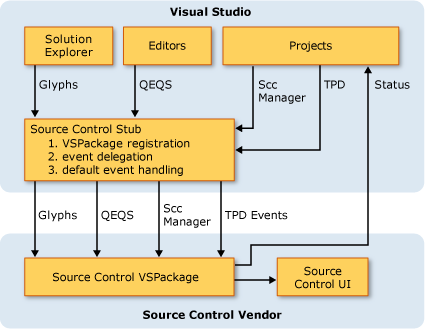Source Control VSPackage Architecture
Note
This article applies to Visual Studio 2015. If you're looking for the latest Visual Studio documentation, see Visual Studio documentation. We recommend upgrading to the latest version of Visual Studio. Download it here
A source-control package is a VSPackage that uses services that the Visual Studio IDE provides. In return, a source-control package provides its functionality as a source control service. Additionally, a source-control package is a more versatile alternative than a source control plug-in for integrating source control into Visual Studio.
A source control plug-in that implements the Source Control Plug-in API abides by a strict contract. For example, a plug-in cannot replace the default Visual Studio user interface (UI). Moreover, the Source Control Plug-in API does not enable a plug-in to implement its own source control model. A source-control package, however, overcomes both of these limitations. A source-control package has complete control over the source control experience of a Visual Studio user. Additionally, a source-control package can use its own source control model and logic, and it can define all the source control-related user interfaces.
Source-Control Package Components
As shown in the architecture diagram, a Visual Studio component named the Source Control Stub is a VSPackage that integrates a source-control package with Visual Studio.
Source Control Stub handles the following tasks.
Provides the common UI that is required for source-control package registration.
Loads a source-control package.
Sets a source-control package as active/inactive.
Source Control Stub looks for the active service for the source-control package and routes all incoming service calls from the IDE to that package.
The Source Control Adapter Package is a special source-control package that Visual Studio provides. This package is the central component for supporting source control plug-ins based on the Source Control Plug-in API. When a source control plug-in is the active plug-in, the Source Control Stub sends its events to the Source Control Adapter Package. In turn, the Source Control Adapter Package communicates with the source control plug-in by using the Source Control Plug-in API and also provides a default UI that is common for all source control plug-ins.
When a source-control package is the active package, on the other hand, the Source Control Stub directly communicates with the package by using the Visual Studio SDK Source-Control Package interfaces. The source-control package is responsible for hosting its own source control UI.

For a source-control package, Visual Studio does not supply source control code or an API for integration. Contrast this with the approach outlined in Creating a Source Control Plug-in where the source control plug-in has to implement a rigid set of functions and callbacks.
Like any VSPackage, a source-control package is a COM object that can be created by using
CoCreateInstance. The VSPackage makes itself available to the Visual Studio IDE by implementing IVsPackage. When an instance has been created, a VSPackage receives a site pointer and an IServiceProvider interface that provides the VSPackage access to the available services and interfaces in the IDE.Writing a VSPackage-based source-control package requires more advanced programming expertise than writing a Source Control Plug-in API-based plug-in.